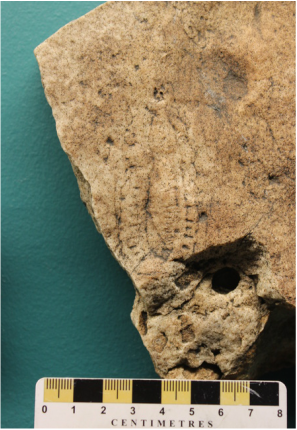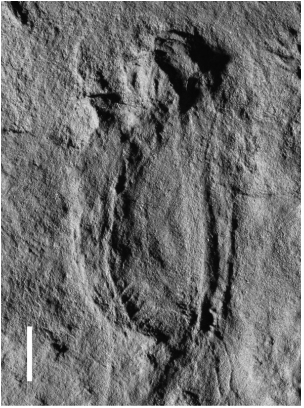KIMBERELLA QUADRATA
Glaessner & Wade, 1966
|
Kimberella quadrata is an important taxon in palaeontology. It has been widely considered to be the most reliable Ediacaran example of an early bilaterian animal, and has therefore been used as a calibration point in modern molecular clock studies (e.g. Benton et al., 2015).
Upon its original discovery, Kimberella was interpreted as an ancient medusoid (jellyfish) (Glaessner & Wade, 1966; Wade, 1972; Jenkins, 1983), however recent analyses have seen Kimberella redescribed as a basal mollusc (e.g. sea snail; Fedonkin & Waggoner, 1997; Ivantsov, 2009; Gehling et al., 2014). Clusters of paired scour marks are often associated with Kimberella, and have been interpreted as scratch marks created by the organism grazing on the microbial substrate: a feeding strategy employed by living gastropods (e.g. snails and limpets). Described from:
Flinders Ranges, South Australia White Sea, Russia Key papers: Fedonkin & Waggoner, 1997 Gehling et al., 2014 Glaessner & Wade, 1966 Ivantsov, 2009 Ivantsov, 2013 Jenkins, 1983 Wade, 1972 Jenkins, R.J.F., 1983. Interpreting the oldest fossil cnidarians. In Proceedings of the 4th International Symposium on Fossil Cnidaria. Paleontographica Americana 54, 95-104. |
|
Diagnosis (from Glassner & Wade 1966):
Ovate bodies, rounded at one end and with a smooth contour; internal structures represented by several longitudinal, distinct zones of two kinds, coarsely segmented or with fine, transverse, frill-like grooves bordering a smooth area.
Ovate bodies, rounded at one end and with a smooth contour; internal structures represented by several longitudinal, distinct zones of two kinds, coarsely segmented or with fine, transverse, frill-like grooves bordering a smooth area.


